|
Page 1 of 5
People are always looking for ways to improve health and get in better shape. They need to look no further than martial arts for the answer. Looking better and feeling stronger and healthier are the major byproducts of adopting a martial arts discipline. There are as many debates about the best way to build strength and increase fitness as there are styles available to the practitioner.
I began my martial arts training in 1990 when I was drafted by the San Diego Chargers. Shortly after my second season in the NFL, I began looking for ways to improve my football skills and overall health. Since I was a huge Bruce Lee fan growing up, I thought a great way to get in shape was learning kung-fu. After all, despite his smallish stature, Lee was a physical marvel. If I could incorporate some of the training techniques that made him pound-for-pound the fastest and most powerful martial artist of his generation, those skills might help me become a better, more effective football player.
I sought the help of a kung-fu instructor in my area and settled on the fantastic, diverse world of shaolin five animal kung-fu, which incorporates the best of both the internal and external disciplines of Chinese martial arts.
Health Benefits
Shaolin five animal kung-fu teaches many fighting techniques, but more importantly it gives the martial artist a great foundation through stance training, breathing applications and a mixture of internal and external energy training. All these attributes help build strength, power and overall health.
Many factors make the five animal form optimal for health and martial arts cultivation: the practitioner will develop physical strength, libido, chi development, bone development and internal spirit. Since these are a mixture of both internal and external training techniques, it is said that when these five things are combined the result is a far superior martial artist.
History
Chan (Zen) Buddhism was introduced to China around A.D. 550. During the North-South dynasty, a monk named Bodhidharma traveled from India to Songshan Mountain in the Henan province, the site of the Shaolin Temple. There he meditated for nine years. At the age of 76, he began teaching healing arts to the monks of the temple. Since the monks spent much of their time in meditation, they were in poor physical condition. Bodhidharma gave them a set of exercises that would develop the physical strength necessary to maintain the monastery and protect them in the event of an attack. He gave them three exercises: lohan shi ba (18 hands of arhats); yi ji jing (book of changing tendons); and xi shui jing (book of washing bone morrow). At the end of the Ming dynasty (1368-1644), Zhue Yuen, Li Sou and Bai Yu Feng developed the five animal form, which helped to complete the new shaolin system and had a major impact on the state of shaolin kung-fu.
The Five Animals
The shaolin five animals consist of dragon, tiger, snake, crane and leopard. Each animal has characteristics that provide the practitioner with an array of offensive and defensive techniques. Only through a mastery of each of these animals can one hope to become a complete kung-fu stylist.
Dragon (Long Xing)
The Chinese dragon represents internal strength. Contrary to popular belief, there is no relation to the Western dinosaur or fire-breathing dragon. Instead, according to Buddhist writings, the Chinese dragon is a mystical creature that can show itself to those he wants, especially to those who have reached the highest levels of enlightenment. Chinese dragons also are said to live in oceans or large bodies of water and are believed to produce rain. They can make themselves large or small, and are sometimes said to be visible within the clouds if you look closely.
The dragon form combines internal and external energy to produce awesome and devastating strikes. Dragon techniques feature circular movements that can penetrate with sudden explosiveness. Though the claw is the primary hand technique used within the dragon form, there are also various palm and fist attacks that add to the dragon form's effectiveness. However, using the waist in a whipping action to generate power is essential to the development of proper dragon energy. The dragon form uses internal conditioning through proper breathing techniques to develop qi (internal energy). This is done by using the lower body to pull in air with relaxed breaths. The breathing develops flexibility, strength and power.
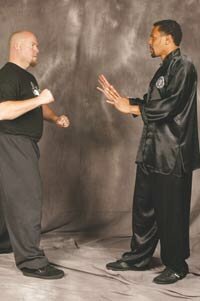
Dragon series. From an on-guard position (1)
|
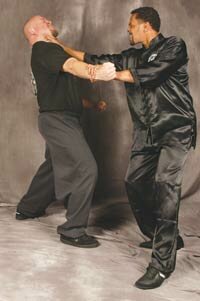
the attacker fires a right punch. Quinn Early counters with a left grabbing block and a right dragon claw to the throat (2)
|
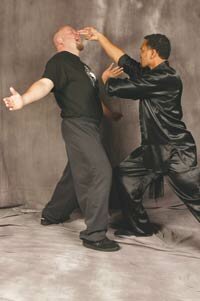
A right two-finger strike to the eyes (3)
|
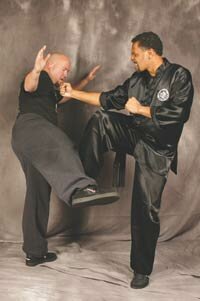
is followed by a sweep of the opponent's front leg (4-5)
|
|
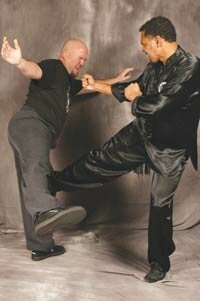
He finishes with a right knife-edge kick to the stationary leg (6)
|
<< Start < Previous 1 2 3 4 5 Next > End >>
|